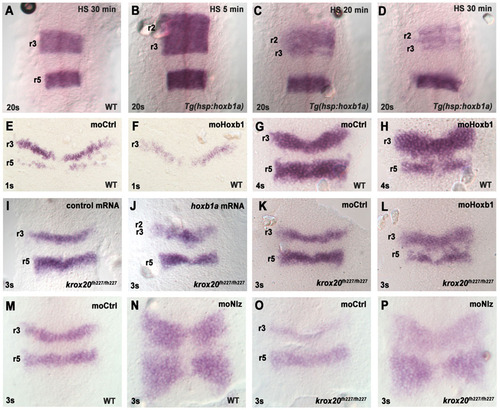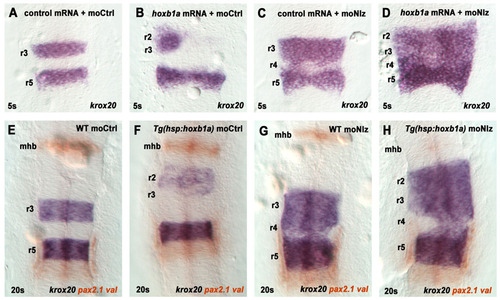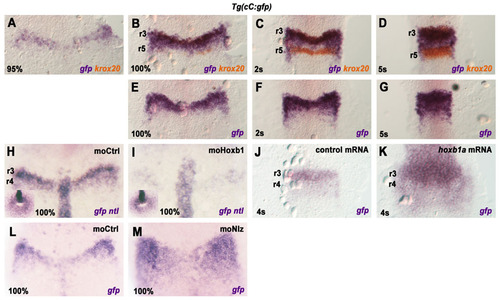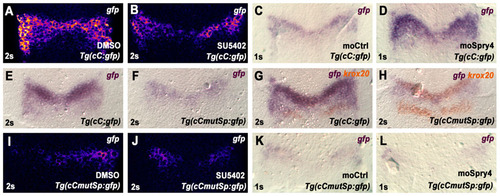- Title
-
Molecular dissection of segment formation in the developing hindbrain
- Authors
- Labalette, C., Wassef, M.A., Desmarquet-Trin Dinh, C., Bouchoucha, Y.X., Le Men, J., Charnay, P., Gilardi-Hebenstreit, P.
- Source
- Full text @ Development
|
Antagonistic actions of Hox PG1 and Nlz factors on krox20 expression and initiation. All embryos were subjected to ISH with a krox20 probe. (A-D) Wild-type (WT) or Tg(hsp:hoxb1a) embryos were heat-shocked (HS) for 5, 20 or 30min at 100% epiboly and collected at 20s (three independent experiments). (E-H) WT embryos were injected with a control morpholino (moCtrl) or morpholinos for hoxb1a and hoxb1b (moHoxb1) and collected at 1s or 4s (three independent experiments). (I,J) krox20fh227/fh227 mutant embryos were injected with 50ng/Ál of control or hoxb1a mRNAs and collected at 3s. (K,L) krox20fh227/fh227 mutant embryos were injected with a control morpholino (moCtrl) or morpholinos for hoxb1a and hoxb1b (moHoxb1) and collected at 3s. (M-P) WT or krox20fh227/fh227 mutant embryos were injected with a control morpholino or morpholinos for nlz1 and nlz2 (moNlz) and collected at 3s. Embryos were flat-mounted with the anterior towards the top (see also Figs 2-6). EXPRESSION / LABELING:
PHENOTYPE:
|
|
Hox PG1 factors regulate nlz1 expression. (A,B) Wild-type (WT) embryos were injected with a control morpholino (moCtrl) or morpholinos for hoxb1a and hoxb1b (moHoxb1), collected at 2s and subjected to in situ hybridization with krox20 (orange) and nlz1 (purple) probes. (C,D) WT and Tg(hsp:hoxb1a) embryos were heat-shocked (HS) for 30min at 100% epiboly, collected at 2s and subjected to ISH for nlz1 (three independent experiments). mhb, mid-hindbrain boundary. EXPRESSION / LABELING:
PHENOTYPE:
|
|
Nlz factors mediate Hox PG1 repression of krox20. (A-D) Wild-type (WT) embryos were co-injected with 50ng/Ál of hoxb1a or cherry-h2b (control) mRNAs, together with either a control morpholino (moCtrl) or morpholinos for nlz1 and nlz2 (moNlz). Embryos were collected at 5s and subjected to in situ hybridization with a krox20 probe. (E-H) WT or Tg(hsp:hoxb1a) embryos were injected with either moCtrl or moNlz, heat-shocked for 30min at 100% epiboly, collected at 20s and subjected to ISH with krox20 (purple) and pax2.1+val (orange) probes. mhb, mid-hindbrain boundary. EXPRESSION / LABELING:
PHENOTYPE:
|
|
Dynamics of enhancer C activity and its regulation by Hox PG1 and Nlz factors. (A-G) Time-course analysis of enhancer C activity. The Tg(cC:gfp) line was analysed by double ISH with gfp (purple) and krox20 (orange) probes, at the indicated stages (A-D). Single ISH was also performed with the gfp probe (E-G). (H,I) Tg(cC:gfp) embryos were injected with a control morpholino (moCtrl) or morpholinos for hoxb1a and hoxb1b (moHoxb1), and subjected to ISH with gfp and ntl probes at 100% epiboly (three independent experiments). The insets show tailbud views of the embryos, allowing the developmental stage to be evaluated by extent of tailbud closure. (J,K) Tg(cC:gfp) embryos were injected with control or hoxb1a mRNA and subjected to ISH with a gfp probe at 4s (three independent experiments). (L,M) Tg(cC:gfp) embryos were injected with a control morpholino or morpholinos for nlz1 and nlz2 (moNlz), and subjected to ISH with a gfp probe at 100% epiboly. EXPRESSION / LABELING:
PHENOTYPE:
|
|
Regulation of enhancer C activity by Fgf signalling. (A-D) Tg(cC:gfp) embryos were treated with control DMSO carrier or SU5402 from the shield stage (A,B), or injected with a control morpholino (moCtrl) or a morpholino for spry4 (moSpry4), and analysed by ISH for gfp (three independent experiments). (E-H) Analysis of enhancer C activity in Tg(cC:gfp) and Tg(cCmutSp:gfp) embryos by single (E,F) or double (G,H) ISH for gfp (purple) and krox20 (orange) at 2s. (I-L) Tg(cCmutSp:gfp) embryos were treated with DMSO carrier or SU5402 from the shield stage (I,J), or injected with a control morpholino (K) or a morpholino for spry4 (S), and analysed by ISH for gfp (three independent experiments). In A,B,I,J, coloration reactions were performed with the Fast Red fluorescent compound to allow for quantification. ISHs were carried out in parallel on siblings under identical conditions. EXPRESSION / LABELING:
PHENOTYPE:
|
|
Sp5 factors mediate Fgf signalling on enhancer C. (A) Gel retardation analysis of the binding of an HA-tagged SP5 protein to an oligonucleotide carrying the Sp site from element C. Antibodies against HA or Flag, and specific (S) or non-specific (NS) oligonucleotide competitors (25- or 100-fold molar excess with respect to the probe) were added as indicated. The positions of specific complexes (arrows), a supershifted complex and the free probe are indicated. (B-E) Tg(cC:gfp) or Tg(cCmutSp:gfp) embryos were injected either with a control plasmid (tol2 vector) or an sp5l expression vector (hsp:sp5l) and heat-shocked for 10min at 95% epiboly. ISH for gfp was performed at 2s for B-I. (F,G) Tg(cC:gfp) embryos were injected with morpholinos against sp5l and bts1 (G), or with morpholinos against these genes, but carrying mismatches (F) (four independent experiments). (H,I) Tg(cC:gfp) embryos were co-injected with morpholinos against sp5l and bts1, and with Cherry (H) or Sp5l (I) mRNAs. (J-N) Tg(cC:gfp) embryos were treated with DMSO (J,L) or SU5402 (K,M) from the shield stage onwards and subjected to gfp ISH at 1s. (N) Distribution of Tg(cC:gfp) embryos according to the expression of gfp. The significance of differences was evaluated by Fisher′s Exact Test: *P<0.05; **P<0.02. EXPRESSION / LABELING:
PHENOTYPE:
|

ZFIN is incorporating published figure images and captions as part of an ongoing project. Figures from some publications have not yet been curated, or are not available for display because of copyright restrictions. EXPRESSION / LABELING:
PHENOTYPE:
|






